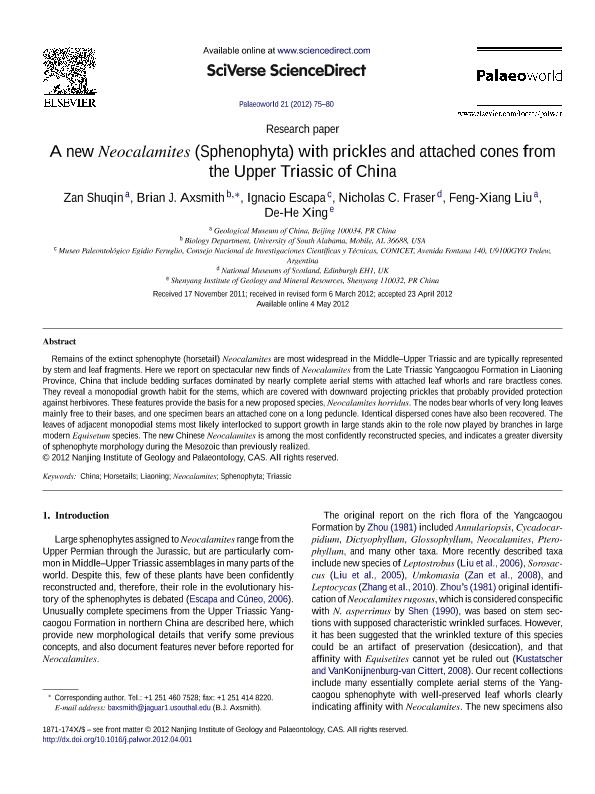Artículo
A new Neocalamites (Sphenophyta) with prickles and attached cones from the Upper Triassic of China
Zan, Shuqin; Axsmith, Brian J.; Escapa, Ignacio Hernán ; Fraser, Nicholas; Liu, Feng Xiang; Xing, De-He
; Fraser, Nicholas; Liu, Feng Xiang; Xing, De-He
 ; Fraser, Nicholas; Liu, Feng Xiang; Xing, De-He
; Fraser, Nicholas; Liu, Feng Xiang; Xing, De-He
Fecha de publicación:
04/2012
Editorial:
Elsevier
Revista:
Palaeoworld
ISSN:
1871-174X
Idioma:
Inglés
Tipo de recurso:
Artículo publicado
Clasificación temática:
Resumen
Remains of the extinct sphenophyte (horsetail) . Neocalamites are most widespread in the Middle-Upper Triassic and are typically represented by stem and leaf fragments. Here we report on spectacular new finds of . Neocalamites from the Late Triassic Yangcaogou Formation in Liaoning Province, China that include bedding surfaces dominated by nearly complete aerial stems with attached leaf whorls and rare bractless cones. They reveal a monopodial growth habit for the stems, which are covered with downward projecting prickles that probably provided protection against herbivores. These features provide the basis for a new proposed species, . Neocalamites horridus. The nodes bear whorls of very long leaves mainly free to their bases, and one specimen bears an attached cone on a long peduncle. Identical dispersed cones have also been recovered. The leaves of adjacent monopodial stems most likely interlocked to support growth in large stands akin to the role now played by branches in large modern . Equisetum species. The new Chinese . Neocalamites is among the most confidently reconstructed species, and indicates a greater diversity of sphenophyte morphology during the Mesozoic than previously realized.
Palabras clave:
CHINA
,
HORSETAILS
,
LIAONING
,
NEOCALAMITES
,
SPHENOPHYTA
,
TRIASSIC
Archivos asociados
Licencia
Identificadores
Colecciones
Articulos(SEDE CENTRAL)
Articulos de SEDE CENTRAL
Articulos de SEDE CENTRAL
Citación
Zan, Shuqin; Axsmith, Brian J.; Escapa, Ignacio Hernán; Fraser, Nicholas; Liu, Feng Xiang; et al.; A new Neocalamites (Sphenophyta) with prickles and attached cones from the Upper Triassic of China; Elsevier; Palaeoworld; 21; 2; 4-2012; 75-80
Compartir
Altmétricas



